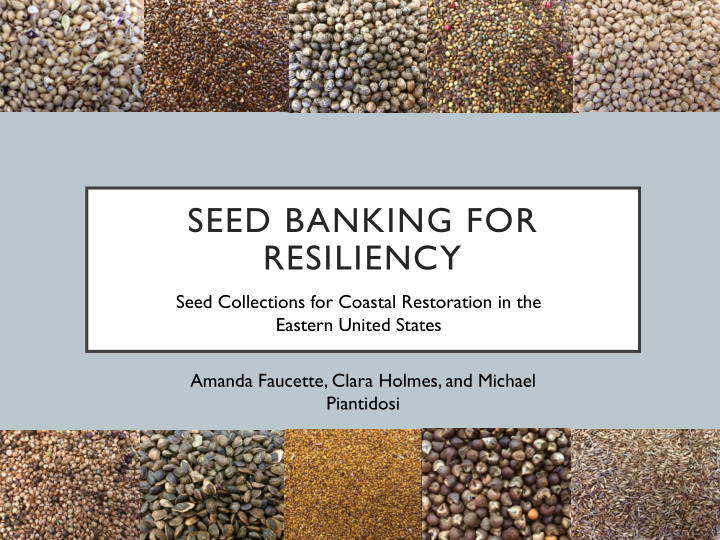



SEED BANKING FOR RESILIENCY Seed Collections for Coastal Restoration in the Eastern United States Amanda Faucette, Clara Holmes, and Michael Piantidosi
BACKGROUND Hurricane Sandy • Landfall New Jersey-October 29, 2012 • • Record storm surge-13.9ft at Battery Park, New York (NOAA 2016) • Second costliest Atlantic Hurricane on record - $71.4 billion (NOAA 2015 Extensive flooding • • Loss of electricity Destruction of businesses and homes and • coastal marshes from Maine to Virginia
BACKGROUND • The Hurricane Sandy Disaster Relief Appropriations provided $892 million to the DOI MARSB, NEWFS and NCBG, though • our partnership with SOS, received $3.2 million for a two year coastal seed collection program • Other partners include the Chicago Botanic Garden and their CLM internship program as well as the Plant Material Center in Cape May NJ as the primary seed cleaning facility
• Restoration • 31 USFWS projects ($102 million) • Restore marshes, wetlands and shorelines • Create habitat connectivity • Reduce flood risk THE NEED FOR SEED • Living Shorelines • Limited seed resources for local ecotypes • Spartina alterniflora – recalcitrant • National Seed Strategy • The right seed at the right place at the right time.
PROJECT GOALS • Develop priority species lists • Hire 14 interns each year for two years through CBG’s CLM program • Make 700 seed collections each year for 2 years • Clean and distribute seed to SSMF Projects “The right seed at the right place at the right time.” Develop germination protocols for all species on the priority • collection list Work to expand partnerships throughout the eastern US that • will contribute to SOS and the NSS
GEOGRAPHIC AREA • Hurricane Sandy - State of Emergency in States from Maine to Virginia NEWFS - ME, NH, MA, RI and CT • • MARSB - NY, NJ and DE • NCBG - MD and VA • 7 Level III EPA Ecoregions • 64 SSMF projects were initially identified as possibly needing plant material 20 projects responded to • outreach efforts and began working with the Project Liaison to ensure collections would be secured
PROJECT EXAMPLES • Prime Hook NWR, DE • 50 acres of Back Dune habitat, 800 acres of mudflats • Blackwater NWR, MD • 45 acres high marsh • Dyke Marsh Wildlife Preserve, VA • 40-50 acres freshwater tidal marsh • Narrow River Estuary Resiliency Restoration • 50 acres of salt marsh
SPECIES • Target species: • Identified most common habitats based on projects that might need seed. • Low and high marsh, primary dune, forested wetlands, freshwater tidal marsh, inland rivers and streams • Based on these habitats, each institution identified the foundation species as well as the most common restoration species • NCBG: 104 • NEWFS: 267 • MARSB: 179 • 44 species of most importance across entire range - ‘Foundation List’
SPARTINA ALTERNIFLORA • Smooth cordgrass, Saltmarsh cordgrass • Dominant species of low marsh • Environmental engineer • Extremely large quantities needed • Recalcitrant • Direct seeding vs. plugs • Demand outstrips supply
COLLECTION AND DISTRIBUTION • Seeds of Success collection protocol • >50 individuals • < 20% of available seed per day • 10,000 seeds per collection min. • Data sheet • Voucher specimens • Distribution T otal PLS ARS Working Collected Collection <2,500 None T otal Collection 2,500-7,500 2,500 Remainder 7,500-30,000 1/3 of total 2/3 of total >30,000 10,000 Remainder
COLLECTIONS • 1,678 collections • 301 species • 169 genera • 20 projects • 848.04 LBS of Spartina alterniflora
GERM TRIALS • Research or establish protocols for species on the “Foundation List” – 44 Species • 35 protocols are already established • Dichanthelium scoparium, Eryngium aquaticum, Gaylussacia frondosa, Lechea maritima, Packera aurea, Pleucea odorata, Symphyotrichum tenuifolium, Teucrium canadense, and Vaccinium pallidum • Make publicly available
PROJECT OUTREACH • Project Liaison • Introductory letter to project managers • Identified 64 projects that might need plant material • Working closely with 20 projects • Delays and lack of information has been challenging
NETWORK DEVELOPMENT • Communications Coordinator • Expanding Seeds of Success in the East • Developed a database of native plant users and producers • Surveys in support of the National Seed Strategy • Implementation of a more formal structure among eastern partners
CONCLUSIONS • Collaboration is key • Project delays • Conserving habitats • Spartina Seeding • Procurement Process • Extension – third year Photo: USFWS
THANK YOU
Recommend
More recommend